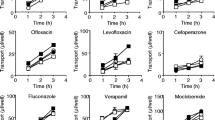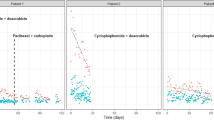Abstract
Purpose
Drug transfer into milk is a general concern during lactation. Because data are limited in human subjects, particularly for new drugs, experimental animal models of lactational drug transfer are critical. This study analyzed drug transfer into milk in a mouse model, as well as the contribution of similar and dissimilar host factors.
Methods
Milk/plasma drug concentration ratios (M/P) in humans were obtained from the literature, while those in mice were determined experimentally after intraperitoneal implantation of osmotic pumps containing drugs of interest. Unbound drug fractions in plasma and milk were determined in vitro for both species.
Results
M/P values were determined for 27 drugs in mice and compared with those in human. These values were increased in mice for 21 drugs; the geometric mean ratio of M/P between mice and humans was 2.03 (95% CI, 1.42–2.89) for all 27 drugs. These results were reasonably explained by the relatively high protein and lipid content in mouse milk. Moreover, species-specific asymmetrical transport systems were suggested for 9 drugs.
Conclusions
In addition to species-specific differences in milk protein and lipid content, variances in asymmetrical drug transport across the mammary epithelium may yield discordant M/P values in humans and mice.





Similar content being viewed by others
Abbreviations
- ABC:
-
ATP-binding cassette
- AUC:
-
area under the drug concentration-time curve
- BCRP:
-
breast cancer resistance protein/ABC transporter G2
- BEH:
-
bridged ethyl hybrid
- C m :
-
drug concentration in milk
- C m,lipid :
-
drug concentration in lipid fraction of milk
- C m,skim :
-
drug concentration in skim milk
- C m,unbound :
-
unbound drug concentration in skim milk
- C p :
-
drug concentration in plasma
- C p,unbound :
-
unbound drug concentration in plasma
- DMSO:
-
dimethyl sulfoxide
- f m :
-
unbound drug fraction in skim milk
- f m,total :
-
fraction of drug free from binding to milk protein and lipid
- f p :
-
unbound drug fraction in plasma
- K f :
-
milk lipid-to-water partition coefficient
- LC-MS/MS:
-
liquid chromatography-tandem mass spectroscopy
- M/P:
-
ratio of drug concentration in milk to that in plasma
- M/Punbound :
-
ratio of unbound drug concentration in milk to that in plasma
- M/Punbound,pred :
-
M/Punbound ratio predicted based on pH partition theory
- OCT:
-
organic cation transporter
- SDS:
-
sodium dodecyl sulfate
- SLC:
-
solute carrier
- UPLC:
-
ultra-performance liquid chromatography
References
Breastfeeding and the use of human milk. Pediatrics. 2012;129:e827–41.
Kramer MS. “Breast is best”: the evidence. Early Hum Dev. 2010;86:729–32.
Guxens M, Mendez MA, Molto-Puigmarti C, Julvez J, Garcia-Esteban R, Forns J, et al. Breastfeeding, long-chain polyunsaturated fatty acids in colostrum, and infant mental development. Pediatrics. 2011;128:e880–9.
Flacking R, Ewald U, Starrin B. “I wanted to do a good job”: experiences of ‘becoming a mother’ and breastfeeding in mothers of very preterm infants after discharge from a neonatal unit. Soc Sci Med. 2007;64:2405–16.
Renfrew MJ, Craig D, Dyson L, McCormick F, Rice S, King SE, et al. Breastfeeding promotion for infants in neonatal units: a systematic review and economic analysis. Health Technol Assess. 2009;13:1–146. iii–iv.
Flacking R, Ewald U, Nyqvist KH, Starrin B. Trustful bonds: a key to “becoming a mother” and to reciprocal breastfeeding. Stories of mothers of very preterm infants at a neonatal unit. Soc Sci Med. 2006;62:70–80.
Jones G, Steketee RW, Black RE, Bhutta ZA, Morris SS. How many child deaths can we prevent this year? Lancet. 2003;362:65–71.
Fleishaker JC. Models and methods for predicting drug transfer into human milk. Adv Drug Deliv Rev. 2003;55:643–52.
Miller GE, Banerjee NC, Stowe Jr CM. Diffusion of certain weak organic acids and bases across the bovine mammary gland membrane after systemic administration. J Pharmacol Exp Ther. 1967;157:245–53.
Atkinson HC, Begg EJ. Prediction of drug distribution into human milk from physicochemical characteristics. Clin Pharmacokinet. 1990;18:151–67.
Begg EJ, Atkinson HC, Duffull SB. Prospective evaluation of a model for the prediction of milk:plasma drug concentrations from physicochemical characteristics. Br J Clin Pharmacol. 1992;33:501–5.
Somogyi A, Gugler R. Cimetidine excretion into breast milk. Br J Clin Pharmacol. 1979;7:627–9.
Shyu WC, Shah VR, Campbell DA, Venitz J, Jaganathan V, Pittman KA, et al. Excretion of cefprozil into human breast milk. Antimicrob Agents Chemother. 1992;36:938–41.
Koshimichi H, Ito K, Hisaka A, Honma M, Suzuki H. Analysis and prediction of drug transfer into human milk taking into consideration secretion and reuptake clearances across the mammary epithelia. Drug Metab Dispos. 2011;39:2370–80.
Dostal LA, Weaver RP, Schwetz BA. Excretion of high concentrations of cimetidine and ranitidine into rat milk and their effects on milk composition and mammary gland nucleic acid content. Toxicol Appl Pharmacol. 1990;102:430–42.
McNamara PJ, Burgio D, Yoo SD. Pharmacokinetics of cimetidine during lactation: species differences in cimetidine transport into rat and rabbit milk. J Pharmacol Exp Ther. 1992;261:918–23.
Gerk PM, Oo CY, Paxton EW, Moscow JA, McNamara PJ. Interactions between cimetidine, nitrofurantoin, and probenecid active transport into rat milk. J Pharmacol Exp Ther. 2001;296:175–80.
McManaman JL, Neville MC. Mammary physiology and milk secretion. Adv Drug Deliv Rev. 2003;55:629–41.
Jonker JW, Merino G, Musters S, van Herwaarden AE, Bolscher E, Wagenaar E, et al. The breast cancer resistance protein BCRP (ABCG2) concentrates drugs and carcinogenic xenotoxins into milk. Nat Med. 2005;11:127–9.
Merino G, Jonker JW, Wagenaar E, van Herwaarden AE, Schinkel AH. The breast cancer resistance protein (BCRP/ABCG2) affects pharmacokinetics, hepatobiliary excretion, and milk secretion of the antibiotic nitrofurantoin. Mol Pharmacol. 2005;67:1758–64.
Alcorn J, Lu X, Moscow JA, McNamara PJ. Transporter gene expression in lactating and nonlactating human mammary epithelial cells using real-time reverse transcription-polymerase chain reaction. J Pharmacol Exp Ther. 2002;303:487–96.
Gilchrist SE, Alcorn J. Lactation stage-dependent expression of transporters in rat whole mammary gland and primary mammary epithelial organoids. Fundam Clin Pharmacol. 2010;24:205–14.
Lucas A, Gibbs JA, Lyster RL, Baum JD. Creamatocrit: simple clinical technique for estimating fat concentration and energy value of human milk. Br Med J. 1978;1:1018–20.
Fleishaker JC, Desai N, McNamara PJ. Factors affecting the milk-to-plasma drug concentration ratio in lactating women: physical interactions with protein and fat. J Pharm Sci. 1987;76:189–93.
Jara-Almonte M, White JM. Milk production in laboratory mice. J Dairy Sci. 1972;55:1502–5.
Piletz JE, Ganschow RE. Genetic variation of milk proteins in mice. Biochem Genet. 1981;19:1023–30.
Mitoulas LR, Kent JC, Cox DB, Owens RA, Sherriff JL, Hartmann PE. Variation in fat, lactose and protein in human milk over 24 h and throughout the first year of lactation. Br J Nutr. 2002;88:29–37.
Montagne P, Cuilliere ML, Mole C, Bene MC, Faure G. Immunological and nutritional composition of human milk in relation to prematurity and mother’s parity during the first 2 weeks of lactation. J Pediatr Gastroenterol Nutr. 1999;29:75–80.
Boumahrou N, Andrei S, Miranda G, Henry C, Panthier JJ, Martin P, et al. The major protein fraction of mouse milk revisited using proven proteomic tools. J Physiol Pharmacol. 2009;60 Suppl 3:113–8.
Bezerra FF, Laboissiere FP, King JC, Donangelo CM. Pregnancy and lactation affect markers of calcium and bone metabolism differently in adolescent and adult women with low calcium intakes. J Nutr. 2002;132:2183–7.
Stock B, Dean M, Levy G. Serum protein binding of drugs during and after pregnancy in rats. J Pharmacol Exp Ther. 1980;212:264–8.
Cooke PS, Kirby JD, Porcelli J. Increased testis growth and sperm production in adult rats following transient neonatal goitrogen treatment: optimization of the propylthiouracil dose and effects of methimazole. J Reprod Fertil. 1993;97:493–9.
Blake HH, Henning SJ. Effect of propylthiouracil dose on serum thyroxine, growth, and weaning in young rats. Am J Physiol. 1985;248:R524–30.
Urakami Y, Okuda M, Masuda S, Saito H, Inui KI. Functional characteristics and membrane localization of rat multispecific organic cation transporters, OCT1 and OCT2, mediating tubular secretion of cationic drugs. J Pharmacol Exp Ther. 1998;287:800–5.
Wang DS, Jonker JW, Kato Y, Kusuhara H, Schinkel AH, Sugiyama Y. Involvement of organic cation transporter 1 in hepatic and intestinal distribution of metformin. J Pharmacol Exp Ther. 2002;302:510–5.
Urakami Y, Okuda M, Masuda S, Akazawa M, Saito H, Inui K. Distinct characteristics of organic cation transporters, OCT1 and OCT2, in the basolateral membrane of renal tubules. Pharm Res. 2001;18:1528–34.
Hasannejad H, Takeda M, Narikawa S, Huang XL, Enomoto A, Taki K, et al. Human organic cation transporter 3 mediates the transport of antiarrhythmic drugs. Eur J Pharmacol. 2004;499:45–51.
Acknowledgments and Disclosures
This work was supported by a research scholarship from the Japan Research Foundation for Clinical Pharmacology, and a Grant-in-Aid for Scientific Research on Innovative Areas HD-Physiology [Grant 22136015] from the Ministry of Education, Science and Culture of Japan.
Author information
Authors and Affiliations
Corresponding author
Electronic supplementary material
Below is the link to the electronic supplementary material.
Supplementary Table 1
(XLS 28 kb)
Supplementary Fig. 1
(PPT 90 kb)
Rights and permissions
About this article
Cite this article
Ito, N., Ito, K., Koshimichi, H. et al. Contribution of Protein Binding, Lipid Partitioning, and Asymmetrical Transport to Drug Transfer into Milk in Mouse Versus Human. Pharm Res 30, 2410–2422 (2013). https://doi.org/10.1007/s11095-013-1085-5
Received:
Accepted:
Published:
Issue Date:
DOI: https://doi.org/10.1007/s11095-013-1085-5




